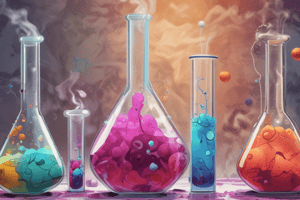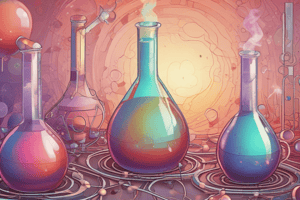Podcast
Questions and Answers
What type of chemical reaction is represented by the equation 2H2 + O2 → 2H2O?
What type of chemical reaction is represented by the equation 2H2 + O2 → 2H2O?
- Synthesis Reaction (correct)
- Double Displacement Reaction
- Decomposition Reaction
- Single Displacement Reaction
What is the purpose of coefficients in a chemical equation?
What is the purpose of coefficients in a chemical equation?
- To indicate the mole ratio of reactants and products (correct)
- To indicate the type of reaction
- To indicate the reactants and products
- To separate reactants from products
What is the final step in balancing a chemical equation?
What is the final step in balancing a chemical equation?
- Count the number of atoms of each element on both sides
- Add coefficients to balance the equation
- Write the unbalanced equation
- Check the equation to ensure it is balanced (correct)
What occurs during oxidation?
What occurs during oxidation?
What is an example of an exothermic reaction?
What is an example of an exothermic reaction?
What type of reaction involves the exchange of partners between two compounds?
What type of reaction involves the exchange of partners between two compounds?
What symbol is used to separate reactants from products in a chemical equation?
What symbol is used to separate reactants from products in a chemical equation?
What is the role of a reducing agent in a reaction?
What is the role of a reducing agent in a reaction?
What type of reaction involves the breakdown of a single compound into two or more substances?
What type of reaction involves the breakdown of a single compound into two or more substances?
What is the term for a reaction that absorbs energy in the form of heat or light?
What is the term for a reaction that absorbs energy in the form of heat or light?
Flashcards are hidden until you start studying
Study Notes
Types of Chemical Reactions
- Synthesis Reactions: Two or more substances combine to form a new compound.
- Example: 2H2 + O2 → 2H2O
- Decomposition Reactions: A single compound breaks down into two or more substances.
- Example: 2H2O → 2H2 + O2
- Single Displacement Reactions: One element displaces another element from a compound.
- Example: Zn + CuSO4 → ZnSO4 + Cu
- Double Displacement Reactions: Two compounds exchange partners, forming two new compounds.
- Example: NaCl + AgNO3 → NaNO3 + AgCl
- Combustion Reactions: A substance reacts with oxygen, releasing heat and light.
- Example: 2CH4 + 3O2 → 2CO2 + 3H2O
Chemical Equations
- A chemical equation represents a chemical reaction using chemical formulas and symbols.
- Chemical equations are written with reactants on the left and products on the right.
- Arrow (→) separates reactants from products.
- Coefficients (numbers in front of formulas) indicate the mole ratio of reactants and products.
Balancing Equations
- Balancing an equation involves adjusting coefficients to ensure the number of atoms of each element is equal on both sides.
- Steps to balance an equation:
- Write the unbalanced equation.
- Count the number of atoms of each element on both sides.
- Add coefficients to balance the equation.
- Check the equation to ensure it is balanced.
Oxidation and Reduction
- Oxidation: The loss of one or more electrons by an atom, molecule, or ion.
- Reduction: The gain of one or more electrons by an atom, molecule, or ion.
- Oxidation and reduction occur simultaneously in a reaction.
- Oxidizing Agent: A substance that causes oxidation (gains electrons).
- Reducing Agent: A substance that causes reduction (loses electrons).
Exothermic and Endothermic Reactions
- Exothermic Reactions: Release energy in the form of heat or light.
- Example: Combustion reactions (e.g., burning gasoline)
- Endothermic Reactions: Absorb energy in the form of heat or light.
- Example: Photosynthesis (plants absorb energy from sunlight)
- Exothermic reactions are often spontaneous, while endothermic reactions require energy input.
Types of Chemical Reactions
- Synthesis reactions involve the combination of two or more substances to form a new compound, such as 2H2 + O2 → 2H2O.
- Decomposition reactions involve a single compound breaking down into two or more substances, such as 2H2O → 2H2 + O2.
- Single displacement reactions involve one element displacing another element from a compound, such as Zn + CuSO4 → ZnSO4 + Cu.
- Double displacement reactions involve two compounds exchanging partners to form two new compounds, such as NaCl + AgNO3 → NaNO3 + AgCl.
- Combustion reactions involve a substance reacting with oxygen, releasing heat and light, such as 2CH4 + 3O2 → 2CO2 + 3H2O.
Chemical Equations
- A chemical equation represents a chemical reaction using chemical formulas and symbols, with reactants on the left and products on the right.
- The arrow (→) separates reactants from products.
- Coefficients (numbers in front of formulas) indicate the mole ratio of reactants and products.
Balancing Equations
- Balancing an equation involves adjusting coefficients to ensure the number of atoms of each element is equal on both sides.
- Steps to balance an equation include: writing the unbalanced equation, counting the number of atoms of each element on both sides, adding coefficients to balance the equation, and checking the equation to ensure it is balanced.
Oxidation and Reduction
- Oxidation is the loss of one or more electrons by an atom, molecule, or ion.
- Reduction is the gain of one or more electrons by an atom, molecule, or ion.
- Oxidation and reduction occur simultaneously in a reaction.
- An oxidizing agent is a substance that causes oxidation (gains electrons), while a reducing agent is a substance that causes reduction (loses electrons).
Exothermic and Endothermic Reactions
- Exothermic reactions release energy in the form of heat or light, such as combustion reactions (e.g., burning gasoline).
- Endothermic reactions absorb energy in the form of heat or light, such as photosynthesis (plants absorb energy from sunlight).
- Exothermic reactions are often spontaneous, while endothermic reactions require energy input.
Studying That Suits You
Use AI to generate personalized quizzes and flashcards to suit your learning preferences.




